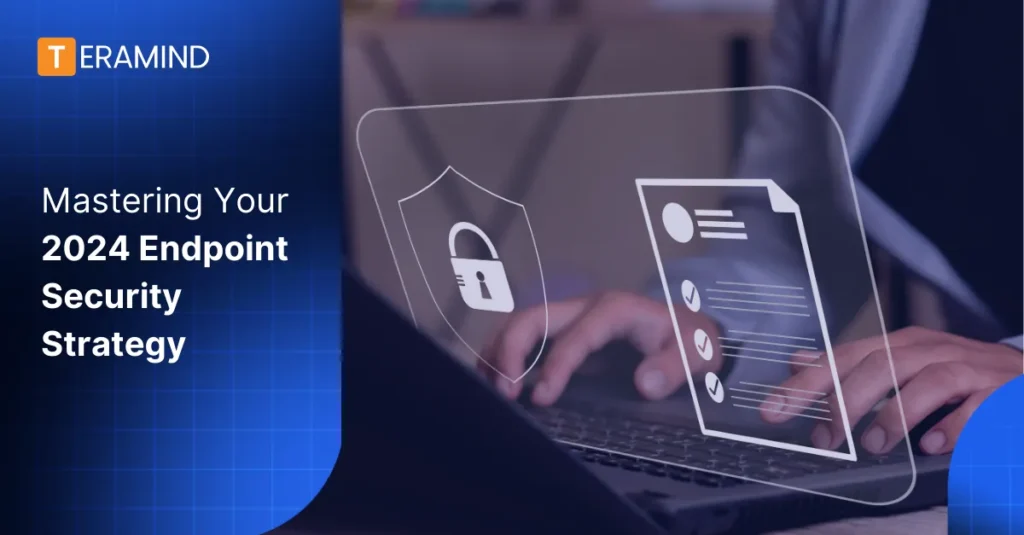In IT, endpoints are the physical devices that connect to a network system. In a corporate environment, endpoints include mobile devices, desktop computers, laptops, servers, and other equipment employees use to access the network and other critical digital systems. A company with fewer than 50 employees typically averages around 22 endpoints, 50-100 employees average more than 100, and companies with more than 1,000 employees average nearly 2,000.
As you can see, endpoints grow at an even faster rate as companies grow. Each endpoint represents a potential security risk to the organization because each is an access point to the network and the company’s sensitive information. If not properly secured, any compromised endpoint could be attacked by malicious external users or used by negligent insiders to expose the organization to potential financial or reputational harm.
Every organization needs a strong endpoint security strategy.
What is an Endpoint Security Strategy?
An endpoint security strategy creates protocols for the organization’s various network components and specific endpoints. This strategy leverages company policies and security best practices to secure endpoints, manage access rights, and effectively monitor endpoint activity to identify abnormal behavior or potential threats.
Examples of endpoints include:
- Desktops
- Smart Devices
- Servers
- Mobile Devices
- Laptops
- Point-of-Sale Devices
Current Trends in Endpoint Security Strategies
Like most IT and security fields, endpoint security is always evolving and improving. These are some of the most important current trends to be aware of in this sector.
The Role of AI & Machine Learning
One of the most important trends in tech is artificial intelligence (AI) and machine learning, which are making it easier than ever to monitor endpoints proactively. Because a robust endpoint security strategy requires constant vigilance and endpoint tracking, it’s particularly hard for a human security engineer to accomplish. Machine learning in security tools makes it much simpler.
Comprehensive cybersecurity strategies can use machine learning models to learn from real-time data to develop a baseline of normal endpoint activity, access privileges, work patterns, and more. Learning from that data allows models to detect anomalous end-user behavior, flag potential threats, and even perform incident response automatically.
Integration with Cloud and Network Security
An endpoint security solution is just one component of a broader security posture. All organizations — especially large ones with many endpoints — should have comprehensive cybersecurity strategies to limit vulnerabilities. As endpoints will be active on your corporate network and cloud-delivered applications, it’s crucial to integrate your endpoint security strategy into your cloud security and network security strategy.
An effective security solution will address all of your business’s various aspects and needs to guarantee secure, authorized access to digital systems.
The Evolving Threat Landscape and the Need for Adaptive Strategies
Cyber threats constantly evolve as hackers and other malicious actors develop new malware, ransomware, phishing attacks, and other scams. Human security teams can’t plan for something they’ve never seen and can only guess future attacks.
An additional benefit of machine learning is its ability to offer adaptive strategies informed by extensive data collection. When a new threat emerges, a robust endpoint security system can work automatically to mitigate that threat using adaptive strategies developed through historical and predictive data.

Protecting a Diverse Range of Devices and Systems
A few sections back, we briefly listed some examples of endpoints. You saw a wide range of devices and systems in just that short list, from smartphones to servers, laptops to POS systems. Depending on your business and network, you may have a highly eclectic mix of endpoints. No matter how many different types of devices are on your network, you need security that accommodates all of them.
As organizations grow, you’re bound to have an increasingly diverse mix of device types, operating systems, brands, and types of equipment connected to your network. Endpoint security strategies must account for that diversity.
Balancing Security with User Experience and Productivity
Security is paramount, but so is productivity. Nobody wants to be locked out of doing their job for a whole day because of an overly sensitive security system. Yes, best practices like multi-factor authentication slightly negatively impact user experience and productivity, but it’s a worthwhile tradeoff.
It’s crucial to strike the right balance between security and productivity, especially in hybrid or remote access situations. When remote workers have limited access to IT or security resources, they need simple security solutions to keep them (and the organization) safe without complicating their job functions.
Components of an Endpoint Security Strategy
The above trends inform an effective endpoint security strategy and should feature several essential security components. Below, we break down some of the most critical components.
Antivirus Software and its Role
Antivirus software is an essential cybersecurity tool that everyone should have. Viruses that find their way onto personal or corporate-owned devices can penetrate the corporate network, leading to corrupted files, broken access privileges, data leaks, and many other negative consequences. Antivirus solutions should be mandatory for all endpoints.
Endpoint Protection Platforms (EPP)
An endpoint protection platform (EPP) is a core component of any endpoint strategy. As the name suggests, this comprehensive protection is deployed on all endpoints to protect against a range of threats. Most EPP solutions are cloud-managed and use machine learning to actively monitor endpoints and remediate threats.
An EPP offers proactive malware and antivirus protection and security against other potential threats. With an EPP, security teams can spend less time actively monitoring all endpoint activity and more time developing incident response plans and security policies.
Endpoint Detection and Response (EDR) Tools
Unlike EPPs, endpoint detection and response tools identify potential malicious activity or suspicious behavior. Using real-time data and continuous monitoring, EDR tools can immediately alert when unrecognized endpoints gain unauthorized access to the network or when a specific endpoint abuses access rights or gains access to corporate assets it shouldn’t have access to. This enables security teams to investigate incidents quickly and contain attacks if necessary.
Behavioral Analysis and Monitoring
Endpoint monitoring tools are becoming more common in the hybrid working world, especially among large enterprises. Companies don’t just want to ensure employees are productive when they’re not in the office; they must also know that employees are practicing good security, remaining compliant in their roles, and not behaving in ways that could harm the company.
Insider threats are common, whether by negligent insiders who make security mistakes or malicious insiders who want to hurt the company somehow. Through behavioral analysis and employee monitoring, security professionals will know when an insider begins unusual behavior, whether downloading extensive amounts of data, frequently accessing sensitive information, working outside regular hours, or any other suspicious activity.
User Access and Privilege Management
It’s very unusual for every employee in an organization to need access to every file or system. While it may be easier to give everyone universal access, it’s not a wise security practice. Users should only have access to files, systems, and third-party tools needed to perform their job role. Of course, as employees climb the ladder, they may gain privileges, but it’s much preferable to give access over time than have to remove it should someone abuse their access rights.
Best Practices for Endpoint Security Strategy
An endpoint security strategy will look different from company to company. That said, some consistent best practices should be considered by all organizations.
Layered Security Approach
Security risks can occur at different levels of your organization’s network infrastructure. A strong endpoint security strategy should feature layers of security that include protections at all levels of your organization:
- System level: Your system-level security is your last defense against attack, so take the time to properly configure your basic system security.
- Network level: Your network security should protect access to your i5/OS operating system and other network systems. A firewall is a standard network security tool and an essential part of an endpoint security strategy, while your internet service provider (ISP) can also provide additional security measures.
- Application level: Most organizations utilize a variety of third-party applications on their networks. A robust endpoint security strategy should implement controls for users’ interaction with specific applications, including monitoring endpoints with access and ensuring access privileges are not abused.
- Transmission level: Data communications within and across networks should have security measures like a Secure Sockets Layer (SSL) certificate and encrypted messaging.
Regular Security Updates and Patch Management
We’ve discussed the ever-evolving nature of threats and the need for adaptive security strategies. It’s not enough to simply trust your automated security system to adapt. You must proactively update your security tools and software and implement patches to keep your organization secure. A security system isn’t a set-it-and-forget-it thing; it requires constant maintenance to stay ahead of new threats and advancements in cybercrime.
Employee Training and Education
Most endpoints are managed by individual employees, often on personally connected devices. As such, employee training is crucial to a successful endpoint security strategy. Employees must understand organization endpoint security policies and security best practices, from updating passwords regularly and turning on multi-factor authentication to data handling compliance and appropriate external communication.
Employee education should be a regular component of your endpoint security strategy. Of course, new employees must learn your organization’s policies, but it’s essential to hold frequent security seminars to keep employees updated on security best practices and trends.
Centralized Management and Visibility
Some organizations struggle with information silos, making it difficult for employees to gain unified visibility into the organization’s knowledge base. There should be no silos in endpoint security. A comprehensive security solution like Teramind will give you a centralized approach to monitoring and, if needed, acting against all endpoint activity. Teramind even supports remote desktop control, allowing security teams to take over individual endpoints to mitigate security incidents before they spiral out of control.
Integration with Other Security Tools and Solutions
Your endpoint security strategy is just one component of your organizational cybersecurity architecture. Echoing the importance of centralized management, it’s important that security teams can seamlessly integrate your endpoint security tools into other security protocols and policies.
From an insider threat program and Data Loss Prevention (DLP) software to employee monitoring and User & Entity Behavioral Analytics (UEBA) tools, all security tools your organization uses should work seamlessly together to achieve a strong security posture.
FAQs
What are the three main types of endpoint security?
The three main types of endpoint security are antivirus software, firewalls, and encryption tools. These tools help protect endpoints from malware, unauthorized access, and data breaches, ensuring a strong security posture for organizations.
What is an endpoint security example?
Endpoint security examples include antivirus software such as Symantec Endpoint Protection and McAfee Endpoint Security, firewalls like Palo Alto Networks Firewall, and encryption tools like BitLocker and VeraCrypt. These tools help protect endpoints from various threats and ensure organizational data security.
What are the three strategies that help secure unknown endpoints?
Implementing device identification and authentication measures, using behavior-based threat detection and tools, and regularly updating and patching endpoint security software are three strategies that help secure unknown endpoints against unauthorized access and potential security threats.
Which endpoint protection technique is commonly used?
One common endpoint protection technique is implementing endpoint detection and response (EDR) solutions. EDR solutions provide real-time monitoring, threat detection, and response capabilities to secure endpoints against advanced threats and attacks.
Conclusion
Organizations face many cybersecurity threats today, and building a security plan is more complicated than ever with so many endpoints on the entire network. Building an effective endpoint security strategy means understanding the current trends to plan for and incorporating strong individual components to protect your organization’s myriad endpoints from insider and external users.


